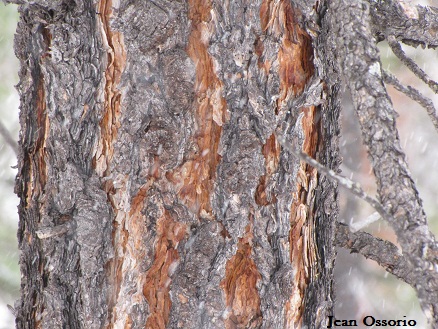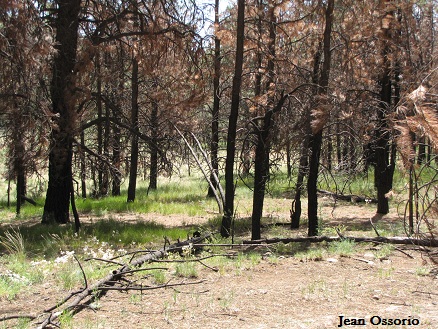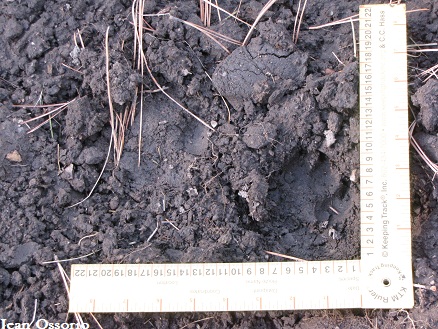Follow the Pack, January 20, 2013
It has been ten months since Follow the Pack posted an account of our adventures in the Blue Range Wolf Recovery Area. We haven’t been idle, however. Here are some highlights from our 2012 visits to Mexican gray wolf home ranges.
Welcoming spring in Middle Fork territory
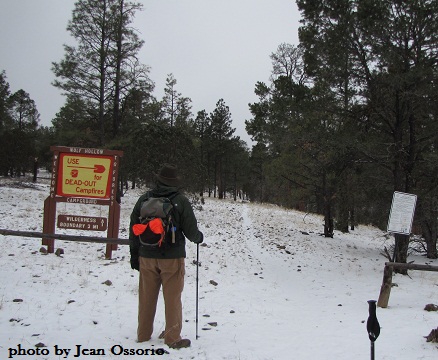 Follow the Pack headed out to the wintery Gila National Forest in mid-March 2012 to look for tracks of one of our favorite packs, the Middle Fork Pack. One snowy morning we put on our boots and packs and hiked up Wolf Hollow, near the eastern edge of the pack’s home range. A white sign to the right of the trail reminded us that we were in wolf territory.
Follow the Pack headed out to the wintery Gila National Forest in mid-March 2012 to look for tracks of one of our favorite packs, the Middle Fork Pack. One snowy morning we put on our boots and packs and hiked up Wolf Hollow, near the eastern edge of the pack’s home range. A white sign to the right of the trail reminded us that we were in wolf territory.
The Wolf Hollow trail follows the creek through a forest that consists mostly of ponderosa pine trees. When the trees are young, their bark is dark gray. As the trees grow, the bark on their trunks develops deep cracks. The bark in the cracks is red-orange.
Eventually, when the tree is much older, the gray disappears and the bark is almost completely red-orange and smooth.
Soon we found signs of one of the creatures that share the habitat of the Middle Fork pack. Can you guess what animal made these holes in the ponderosa pine tree?
If you guessed that a woodpecker made these holes, you’re right. An acorn woodpecker drilled these holes to store its favorite food, acorns! If you look carefully, you can see acorns in some of the holes in the picture. You can see acorn woodpeckers in action at this link.
On the first day of spring, we visited Cooney Prairie, another place the Middle Fork pack calls home. We didn’t see any sign of the wolves, but we did find sign left by one of their favorite prey animals. Do you know who left these droppings?
It was an elk, probably one from this herd.
These elk were part of a large herd. We watched the herd as it crossed the prairie and finally disappeared into the trees on the other side. 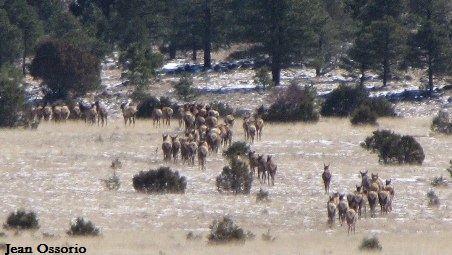

In June we paid another visit to the home range of the Hawk’s Nest pack. The alpha female of Hawk’s Nest, AF1110, had been killed by a lightning strike in August 2011. (For more on AF1110, click here.) Her daughter, AF1208, had become the new alpha female. We were hoping to find tracks of the Hawk’s Nest wolves, or perhaps hear them howl. We were also interested in seeing how the Wallow Fire, which swept through the pack’s home range in May and June 2011, had affected the wolves’ habitat.
We soon learned that the fire had not made a clean sweep through Hawk’s Nest territory. It had burned some areas heavily, but had barely touched other parts of the pack’s range. Some trees were completely scorched. Others were still green.
Nearly everywhere, green plants were coming up under the burned trees.
The open meadows had suffered very little damage. Animals like these elk were eating the lush, green grasses and drinking from pools of fresh water. 
 After watching the elk for a few minutes, we sat down to rest and eat lunch in the shade of a tree at the far edge of the meadow. Soon we noticed a dog-like animal coming across the grassy meadow. We could clearly see the dark radio collar around the creature’s neck. It was Hawk’s Nest AF1208, the new alpha female. Her fur looked wet. She must have been wading in the water in one of the pools in the creek bed.
After watching the elk for a few minutes, we sat down to rest and eat lunch in the shade of a tree at the far edge of the meadow. Soon we noticed a dog-like animal coming across the grassy meadow. We could clearly see the dark radio collar around the creature’s neck. It was Hawk’s Nest AF1208, the new alpha female. Her fur looked wet. She must have been wading in the water in one of the pools in the creek bed.
As soon as AF1208 disappeared into the trees, we noticed another wolf much farther away across the valley–so far away that it was impossible to see well, even with binoculars. Only after we got home and looked carefully at one of our photos on the computer were we able to see the back leg that AM1038 carries at a strange angle, due to an old injury he suffered while alpha male of the Fox Mountain Pack in 2008. Can you see that he isn’t putting any weight on his right rear leg?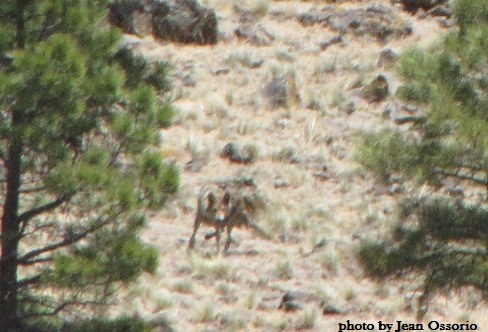 In August, Follow the Pack returned to the wolf recovery area to help lead a workshop on tracking animals. Here the instructor demonstrates how to trace a track on a sheet of acrylic material. Tracing tracks requires careful observation, which helps in identifying them.
In August, Follow the Pack returned to the wolf recovery area to help lead a workshop on tracking animals. Here the instructor demonstrates how to trace a track on a sheet of acrylic material. Tracing tracks requires careful observation, which helps in identifying them. 
Three visits to Fox Mountain territory
The home range of the Fox Mountain Pack in New Mexico was our destination in September. We didn’t see the wolves, but we did see several of the creatures that share their habitat. This red-tailed hawk posed for several photos before taking off from the top of the tree where it sat. 
A snake swimming in a stock tank”¦
…and a tarantula at our campsite were among the wild creatures we observed.
When we returned to Fox Mountain territory in early November, the weather had changed. Nights were cold. The wildflowers we saw in September had disappeared, leaving behind their seeds. Fresh snow greeted us one morning.
Although we always welcome a snowfall, because it makes tracking easier, the real highlight of our trip was seeing the tracks of one of the Fox Mountain pups in the muddy bank of a stock pond near our camp.
In the second photo, the larger track on the left is a front track, and the smaller one on the right is a rear track. Just like your domestic dog, wolves have front paws that are larger than their rear paws. (If you have a dog, take a look at its paws and see for yourself!) Larger front paws help support the greater weight of the head and chest at the front of the dog or wolf.
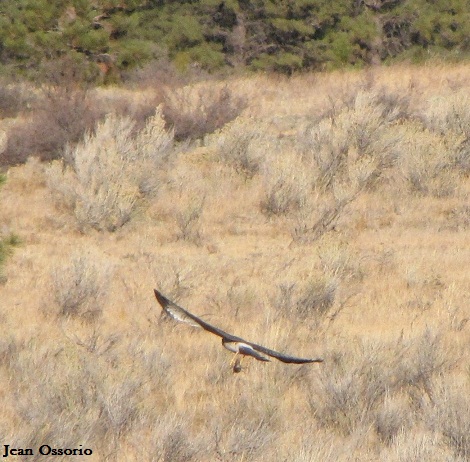 When we returned to Fox Mountain territory in late November, we found no wolves, but lots of other wildlife. While drinking our morning coffee, we watched this northern harrier swoop down, snatch a small animal from the grass, and carry it off for breakfast.
When we returned to Fox Mountain territory in late November, we found no wolves, but lots of other wildlife. While drinking our morning coffee, we watched this northern harrier swoop down, snatch a small animal from the grass, and carry it off for breakfast.
A short while later, a large herd of elk came running down the hill toward our camp. We heard them before we saw them. Their hooves pounded, sounding like thunder as they ran. When they saw us, they turned, ran up the hill, and disappeared, only to reappear in a few minutes on a ridge across the forest road. They started to move down toward the road, then stopped, looked around, and again ran up and over the ridge.

Although we didn’t see or hear the wolves, the elk made our short visit memorable.

Follow the Pack has been taking mid-winter camping trips in Mexican gray wolf home ranges since 2001. This year, we left for the Luna Pack’s home range the day after Christmas. Because we got a late start, we spent the first night of our trip at the Datil Well Campground, which is near the wolf recovery area, but not actually in it. This sign at the Bureau of Land Management campground gives a little history of the area.
According to the sign, the peak year for “trailing” cattle and sheep along the “hoof highway” from Springerville, AZ, to the railroad at Magdalena, NM, was 1919. This was also the heart of the period during which federal agents were shooting, trapping, and poisoning hundreds of wolves and other predators in the Southwest on behalf of the livestock industry. (For more about lobo history, check this link.)
Mexican wolves travel widely within their home ranges during winter. Pups are beginning to move around separately from the rest of their packs. It can be difficult to predict from one week to the next where a pack will be. The same snow that makes seeing tracks easy may also make roads impassable. After studying the map and checking on weather predictions, we decided to look for tracks and listen for howls of the Luna Pack in New Mexico.
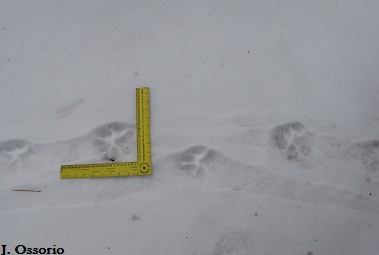
We found a campsite with a view of a large open area. If wolves or a herd of elk came along, we would be very likely to see them. As we set up our tent and fixed dinner, snow clouds gathered. 
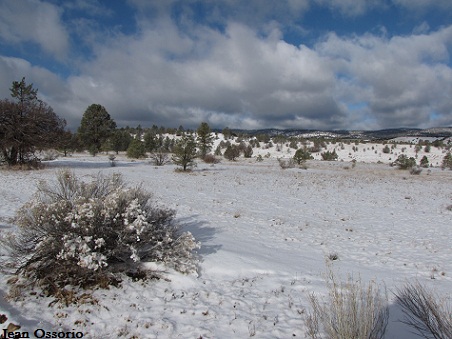
When we hear wolf howls and find wolf tracks, we are reassured that at least some of the reintroduced lobos are thriving, hunting elk, raising pups, and patrolling their home ranges, in spite of all obstacles. We rarely see them—only once out of 24 days camping in their home ranges in 2012—but just knowing they are there is enough. As long as the lobos survive in the Southwest, Follow the Pack will be out looking for them and reporting what we find.
For more adventures in Mexican gray wolf territory, read earlier Follow the Pack posts here.

